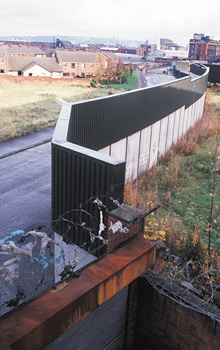
Comunque, fin dall’inizio degli anni Settanta, l’esercito inglese costruì barriere divisorie permanenti per separare le due comunità, mentre la violenza cresceva nelle strade.
Ci sono stati molti dibattiti per discutere se e come eventualmente eliminarle, ma ad oltre 10 anni dalla firma dell’Accordo del Venerdì Santo i muri restano al loro posto.
La maggioranza di essi si trova a Belfast – con 42 peaceline, è molto più di una città divisa da mattoni e malta. Ci sono anche cinque muri divisori a Derry, cinque a Portadown ed uno a Lurgan. Negli ultimi tempi i muri sono diventati un’attrazione turistica, insieme ai murales, ai disegni ed ai graffiti che adornano la base di molte strutture.
Timore per ciò che potrebbe succedere qualora i muri venissero abbattuti, assicurano la loro esistenza, con il sostegno di entrambe le comunità. Gli ingegneri dell’esercito britannico hanno eretto la prima grande peaceline attraverso Crumlin Road, a North Belfast, nel giugno 1970.
Oggi la parte maggiore dei muri percorre la lunghezza di Springfield Road, dividendo la nazionalista West Belfast dai loro vicini di Shankill. Con numerose porte di accesso, il muro – costruito con oltre un milione di mattoni – è stato un punto focale per la violenza nel corso degli anni, negli ultimi anni incentrata principalmente intorno alla parata dell’Orange Order di Whiterock.
E mentre il suo proposito era di salvare vite umane creando una zona cuscinetto, il muro è stato utilizzato come punto di attraversamento dai killer lealisti nel corso degli anni.
Ad aprile 1994 Paul ‘Topper’ Thompson fu colpito in Springfield Park da un commando dell’UDA a poca distanza dalla gigantesca peaceline che divide la cattolica Moyard dal quartiere lealista di Springmartin. Durante la stessa giornata una donna, residente a Moyard, aveva avvertito la RUC e il Northern Ireland Office che un buco era stato aperto nella barriera di sicurezza.
Proprio attraverso quel buco i lealisti entrarono nell’area cattolica e riuscirono ad uscire indenni dopo aver assassinato il 25enne Thompson.
La maggioranza delle peaceline di Belfast sono inframezzate nella parte nord della città. La più recente venne costruita in seguito alla disputa sorta intorno alla Holy Cross nel 2001.
La conformazione demografica di North Belfast obbliga le comunità a vivere schiena contro schiena, con i muri a costituire una visibile zona cuscinetto.
Belfast divided backs still to the wall 40 years on
There has been much debate as to when and how they might eventually come down but more than a decade after the signing of the Good Friday Agreement the walls remain.
The majority are in Belfast – with 42 official peacelines, it is still very much a city divided by bricks and mortar. There are also five security divides in Derry, five in Portadown and one in Lurgan. In recent times the walls have became an unlikely tourist attraction, with murals, artwork and graffiti adorning the base of many of the structures.
Fear of what might happen should the walls come down ensures they continue to exist with the backing of both communities. British army engineers erected the first major peaceline across the Crumlin Road in north Belfast June 1970.
Today the largest of the walls stretches the length of the Springfield Road, keeping the predominantly nationalist west Belfast separate from neighbours in the Shankill area. With several access gates, the wall -–which is made up of over one million bricks – has been a focal point for violence over the years, in recent times centring mainly around the Orange Order Whiterock parade.
And while its purpose was to save lives by forming a buffer zone, the wall has been used as a crossing point for loyalist assassins over the years.
In April 1994 Paul ‘Topper’ Thompson was shot in Springfield Park by UDA gunmen just yards from the giant peaceline which divides the Catholic Moyard from the loyalist Springmartin estate. Earlier that day a female resident had reported to the RUC and the Northern Ireland Office that a hole had been cut in the security barrier.
It was through this hole that the loyalist gunmen entered the Catholic area and made good their escape after murdering 25-year-old Mr Thompson.
The majority of Belfast’s peacelines are interspersed across the north of the city, the most recent of which was built following the 2001 Holy Cross blockade.
The demographic of north Belfast means that communities continue to live back to back with the walls acting as a visible buffer zone.